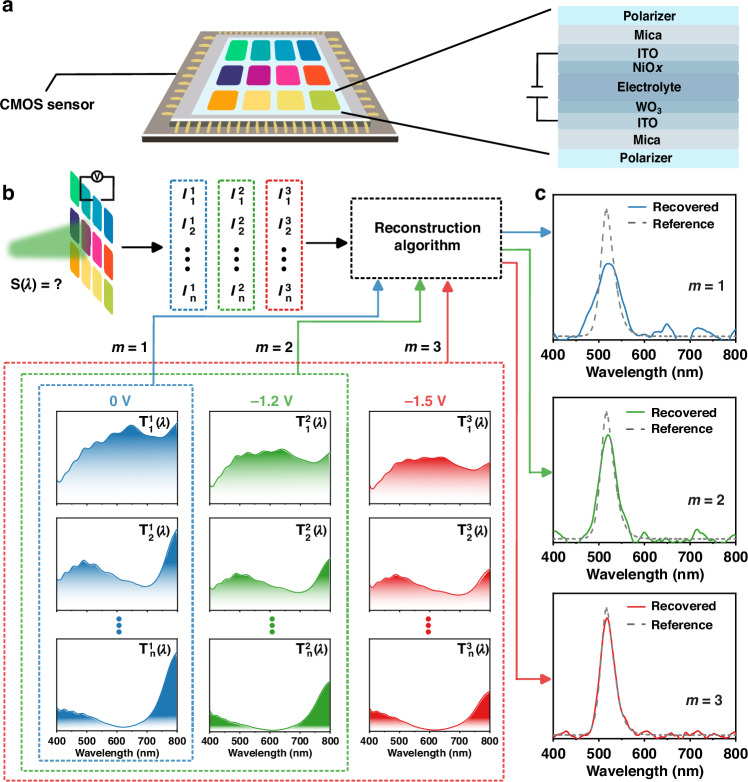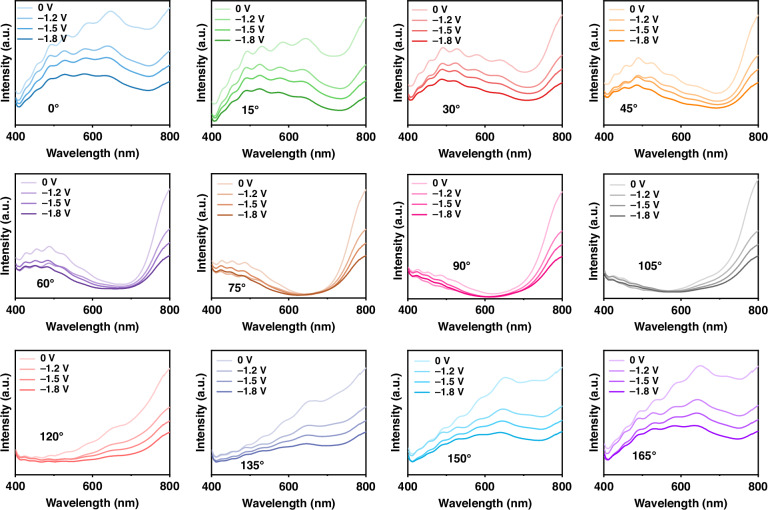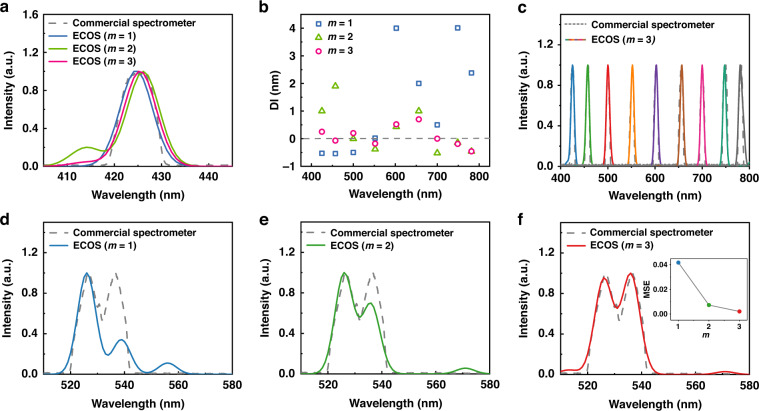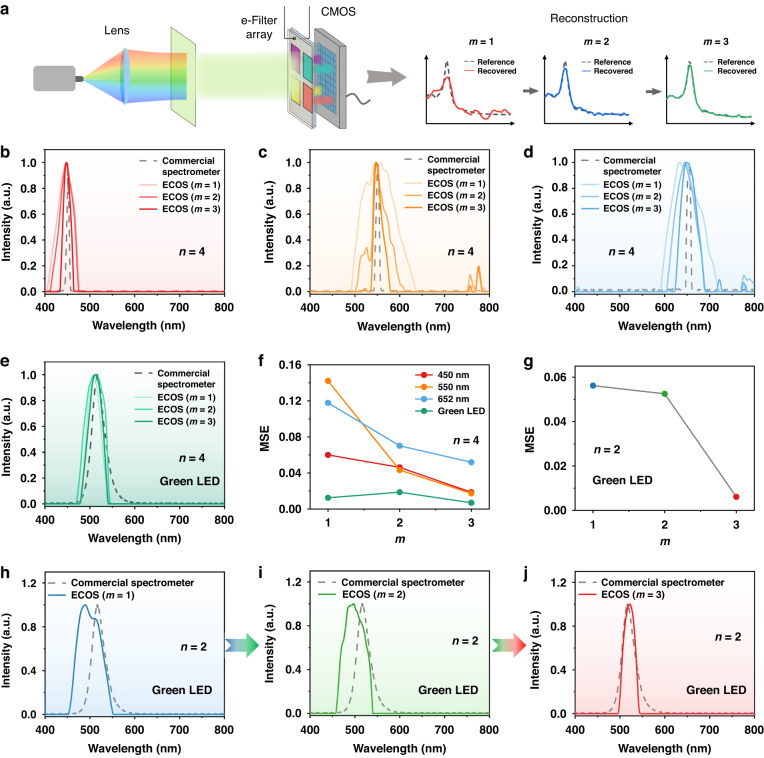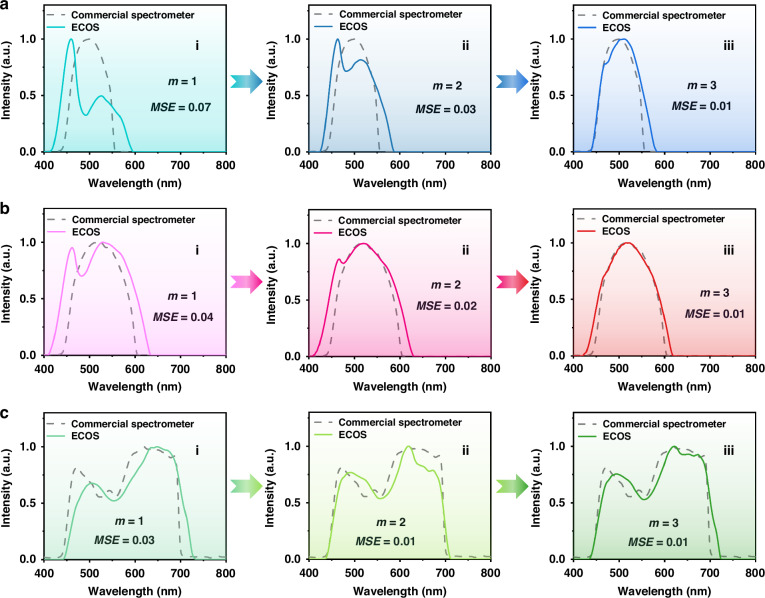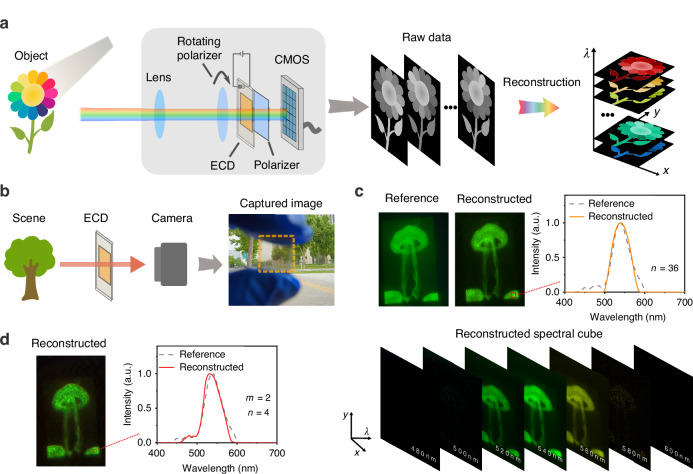Abstract
Miniaturized on-chip spectrometers with small footprints, lightweight, and low cost are in great demand for portable optical sensing, lab-on-chip systems, and so on. Such miniaturized spectrometers are usually based on engineered spectral response units and then reconstruct unknown spectra with algorithms. However, due to the limited footprints of computational on-chip spectrometers, the recovered spectral resolution is limited by the number of integrated spectral response units/filters. Thus, it is challenging to improve the spectral resolution without increasing the number of used filters. Here we present a computational on-chip spectrometer using electrochromic filter-based computational spectral units that can be electrochemically modulated to increase the efficient sampling number for higher spectral resolution. These filters are directly integrated on top of the photodetector pixels, and the spectral modulation of the filters results from redox reactions during the dual injection of ions and electrons into the electrochromic material. We experimentally demonstrate that the spectral resolution of the proposed spectrometer can be effectively improved as the number of applied voltages increases. The average difference of the peak wavelengths between the reconstructed and the reference spectra decreases from 1.61 nm to 0.29 nm. We also demonstrate the proposed spectrometer can be worked with only four or two filter units, assisted by electrochromic modulation. In addition, we also demonstrate that the electrochromic filter can be easily adapted for hyperspectral imaging, due to its uniform transparency. This strategy suggests a new way to enhance the performance of miniaturized spectrometers with tunable spectral filters for high resolution, low-cost, and portable spectral sensing, and would also inspire the exploration of other stimulus responses such as photochromic and force-chromic, etc, on computational spectrometers.
Subject terms: Applied optics, Optical spectroscopy
We demonstrate a computational on-chip spectrometer using electrochromic filter-based computational spectral units that can be electrochemically modulated to increase the efficient sampling number for higher spectral resolution.
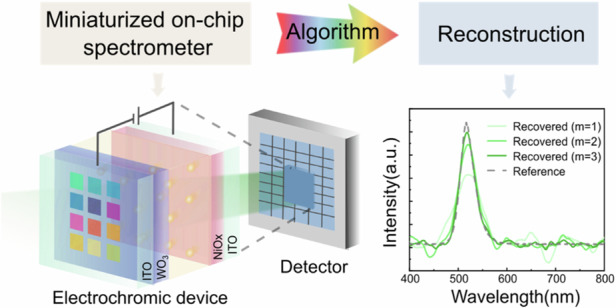
Introduction
Spectrometers have been widely used in fundamental scientific research, industrial inspection, and consumer electronics1–5. Traditional benchtop spectrometers offer high spectral resolutions by using bulky light-dispersive components and long optical path lengths. As a counterpart, miniaturized spectrometers, which have reduced footprint, weight, and cost, are in high demand for portable optical sensing or lab-on-a-chip systems6–9. Recently, on-chip spectrometers utilizing reconstruction algorithms have emerged as a prominent research focus. This trend is attributed to their streamlined optical hardware by leveraging the power of computational techniques9–34. Such spectrometers typically employ random spectral filters or spectral response units, instead of bulky dispersive optics (e.g., grating and prism)35, narrowband filters36, or microelectromechanical systems (MEMS)37,38. Various approaches have been employed to achieve computational spectrometers, including quantum dot filter arrays15–17, photonic crystal arrays18,19, plasmonic microfilter arrays14,24, and in situ perovskite modulation21.
Computational on-chip spectrometers use reconstruction algorithms to evaluate the target spectrum by considering the pre-calibration characteristics of used filters and their response to the tested light. More spectral response units result in better recovered spectral resolution. In other words, improving the number of integrated filters would enhance the performance of computational spectrometers or the resolution is limited by the number of integrated filters. To develop a computational spectrometer without increasing its size, we turn to harness the power of electrochromism. Electrochromism is a phenomenon that reversibly changes the color or transmission spectrum, and other optical properties of materials as a response to the drive of an external electrical voltage. The basis for such a change comes from the reversible redox reactions that occur when cations and electrons are embedded in, or detached from the electrochromic materials39–42. Electrochromic devices (ECD) have electrically tunable spectral response characteristics with high color change sensitivity over a wide spectral range, suggesting that the sampling numbers in computational spectrometers can possibly be improved by applying electrical stimulation on spectral filters, without increasing the number of filters or spectrometers’ size.
In this work, we report an electrochromic computational on-chip spectrometer (ECOS) that can utilize voltage-induced spectral modulation to increase the sampling numbers for enhanced performance of recovered spectra. The filter array is composed of different electrochromic filters-based computational spectral units. It has a footprint of about 1 cm × 1 cm and is integrated on the top of a complementary metal–oxide–semiconductor (CMOS) sensor. The spectral response functions of the filters are tuned by applying different voltages. We investigated the reconstructed spectrum performance of monochromatic and complex spectra by ECOS at different voltages. The ECOS can resolve the spectrum that has two peaks separated by 10 nm with improved spectral resolution as the increase of applied voltages. We also demonstrate that the on-chip spectrometers with only two or four filter units are possible with the aid of electrochromics. Our ECOS concept suggests a novel strategy to improve the sampling numbers in miniaturized spectrometers, for better spectral performance, in a cost-effective way. It can be further extended by applying the spectral modulations in the other stimulus responses such as photochromic and force-chromic, etc.
Results
The electrochromic filter array consists of two polarizers with different polarization angles and an ECD embedded between them. The electrochromic filter array, which has a size of 1 cm × 1 cm, is integrated directly on top of the COMS sensor to form the ECOS, as shown in Fig. 1a. The photo of ECOS is shown in Fig. S8. Each electrochromic filter has a unique transmission spectrum due to the chromatic polarization effect induced by the birefringent property of ECD, modulated by the polarization angles of the two polarizers. In addition, the transmission spectrum of each electrochromic filter can also be tuned by applying different voltages to the ECD. The ECD is the thin-film stacks combined with five layers of ITO/WO3/electrolyte/NiOx/ITO deposited on mica substrate, in which mica has birefringent properties43, WO3 and NiOx were chosen as the cathode electrochromic layer and the anode electrochromic layer, respectively, due to their excellent electrochromic properties39–42. More details of the electrochromic principles can be found in Supplementary Information.
Fig. 1. Scheme and principle of the proposed electrochromic computational on-chip spectrometer (ECOS).
a Schematic of ECOS, which consists of an electrochromic filter array on top of the CMOS sensor. The electrochromic filter array consists of an ECD embedded in two polarizers with different polarization angles. The ECD consists of five layers of ITO/WO3/electrolyte/NiOx/ITO on a mica substrate. b Principle of ECOS. The transmission spectra of different electrochromic filter units at different voltages (‘0 V’, ‘−1.2 V’, and ‘−1.5 V’). refers to the unknown light for testing. c The reconstructed spectra at different voltages. The m denotes different detection modes: ‘m = 1 (blue)’ refers to the mode of using only ‘0 V’, ‘m = 2 (green)’ refers to the mode of using ‘0 V’ and ‘−1.2 V’, and ‘m = 3 (red)’ refers to the mode of using ‘0 V’, ‘−1.2 V’, and ‘−1.5 V’
The conventional on-chip spectrometers rely on engineered spectral filters or chromatic detection units that have fixed spectral responsivity. Increasing the number of filter units n in a given spectral range improves the spectral resolution, however, the number of filter units is limited for a computational spectrometer with a certain size in practical applications. The electrochromic filter units have different spectral responses at different voltages, which means that the sampling number can be increased by tuning the transmission spectra. Each filter with a different polarization angle has a unique transmission spectrum, and the same filter with different voltages also exhibits different spectral characteristics and constitutes the response function (Fig. 1b, red dot line box). This pre-calibrated response function together with the measured unknown transmission intensity at different voltages are processed by algorithms to reconstruct the unknown spectrum.
The operation principle of the proposed ECOS is shown in Fig. 1b. is the transmission spectrum produced by the ith electrochromic filter under the kth (k = 1, 2, 3) applying voltages. Here, the three used voltages were 0 V, −1.2 V, and −1.5 V, respectively. The set of transmitted light intensity , corresponding to the response of each filter, is measured by the CMOS sensor simultaneously:
| 1 |
where i = 1, 2,… n, n is the number of filter units, λ is the wavelength, S(λ) is an arbitrary incident light spectrum, is the quantum efficiency of the sensor, and are the minimum and maximum detectable wavelength, respectively. The m (m = 1, 2, 3) in Fig. 1c denotes different detection modes, where m = 1, 2, 3 represent the usage of ‘0 V’, ‘0 V, −1.2 V’, and ‘0 V, −1.2 V, −1.5 V’ sampling voltages, respectively. The measured intensity at m voltage groups, together with the pre-calibrated response function of m voltage groups are used to reconstruct the spectrum (Fig. 1b, c). The schematic of the optical setup for calibration and measurement of the ECOS is shown in Fig. S7.
Figure 2a is the schematic diagram of ECD with the five-layer structure. Figure 2b elucidates the cyclic voltammetry (CV) curves of the device at different voltage ranges at a scan rate of 100 mV s−1. All CV curves show similar shapes and none of them showed polarization. The device can operate normally and stably in the large voltage range of −1.8 V to 1.8 V. It is also possible to increase the operating voltage as required. The size of the area enveloped by the CV curve corresponds to the ability of the electrochromic film to accept ion embedding and detachment during the color change process, and at the same time reflects the color change performance of the electrochromic film. The larger envelope area represents the larger charge capacity and the higher color change dimming amplitude. It can be seen that the envelope area increases with the expansion of the voltage window, which means it allows more ions to participate in the color change process, resulting in lower transmission spectra (Fig. 2c). The color change is shown in the inset, and it can be clearly seen that the color changes gradually from transparent to blue as the charging voltage increases. The CV curve and corresponding capacitance of the ECD at different scan rates are shown in Figs. S1 and S2. The CV curve shows a similar shape, indicating that the device has excellent rate behavior. The ECDs are positioned between two polarizers (Fig. 2d). Due to the chromatic polarization effect, refer to the birefringence and the dispersion of ECD, different polarization angles of the first polarizer (P1) can provide different transmission colors. Figure 2e illustrates the color change of the ECD at various polarization angles. Unlike traditional ECDs that change color from transparent to indigo blue, combined with the electrochromic effect, the device exhibits a variety of colors such as green, purple, and red as the polarization angle changes from 0° to 165°. The colors at the same angle change gradually as the voltage changes. The corresponding transmittance spectra without applied voltage are shown in Fig. 2f, the transmittance spectra at different angles are highly variable and can be used for spectral modulation in computational spectrometers. Figure S4 provides evidence that the device has a broad variation of CIE coordinates in different angles with a wide range of color spans and rich color modulation. Notably, the device has eminent optical stability, since the transmittance intensity remains unchanged for more than 200 cycles as shown in the in situ transmittance evolution curve at 550 nm of ECD (Fig. 2g). More transmittance evolution curves are shown in Fig. S3.
Fig. 2. Optical characteristics of the ECD.
a Schematic diagram of the ECD structure. b The cyclic voltammetry (CV) curves and c transmittance spectra with the different potential ranges for ECD at a sweep rate of 100 mV s−1. d Schematic of the polarizers modulated ECD unit. The transmission spectra of the unit can be tuned by applying different polarizer angles of P1. e Color variation of ECD corresponds to different polarization angles and voltages. f Transmittance spectra of ECD (bleached state) at different polarization angles. g Transmittance evolution curves of the ECD at a wavelength of 550 nm. The time varies from 0 to 4000 s with the device cycling on/off 200 times. It shows the transmittance for the 1st, 100th, and 200th cycles, with results for the remaining cycles omitted and marked as a break on the x-axis
The performance of the computational spectrometer depends on the variability of its wavelength-dependent optical response. To further observe the spectral response of the electrochromic filter, we measure the transmission spectra of the ECD with different polarization angles at different voltages, as shown in Fig. 3. With a wavelength range of 400–800 nm and a step of 1 nm, these spectra vary with different applied voltages of ‘0 V, −1.2 V, −1.5 V’ and an additional ‘−1.8 V’. In this work, we choose the first three voltages for the verification of the proposed spectrometer. However, other voltages such as the ‘−1.8 V’ may be further explored for increased spectral accuracy of reconstructions, as the corresponding spectra still change.
Fig. 3.
Measured transmission spectra of the ECD at different voltages for different polarization angles
To investigate the spectral resolution of ECOS, we measured the spectrum of monochromatic lights (Fig. 4). Figure 4a shows the reconstructed spectra of monochromatic light at 425 nm with working mode (m = 1, 2, and 3). The three reconstructed spectra show good agreement with the input spectrum (measured by commercial spectrometers), with more sampling data providing better reconstruction results (e.g., mode m = 3). Figure 4b shows the quantified difference between the reconstructed peak wavelength and reference peak wavelength. As the working mode m varies from 1 to 3, the sampling number increases (12, 24, 36 for m = 1, 2, 3, respectively), and the resultant average difference is reduced from 1.61 nm (m = 1) to 0.65 nm (m = 2), 0.29 nm (m = 3). We further present the reconstructions of nine representative narrowbands’ transmission spectra in the range of 400–800 nm at the mode of m = 3 in Fig. 4c, which agree with the reference spectra measured from the commercial spectrometer (USB4000-UV-VIS-ES, Ocean Optics). Furthermore, we measured a complex spectrum that has two mixed peaks separated by 10 nm at around 530 nm. The reconstruction of m = 3 (Fig. 4f) shows high-quality agreement with the reference spectrum, while the ones of m = 1, 2 show the loss of part of the spectrum (Fig. 4d, e). We quantify the performance of ECOS by the mean square error (MSE, lower is better), which is defined as follows:
| 2 |
where M is the spectral length, and and are the normalized reference spectrum and normalized reconstructed spectrum, respectively. The MSE values of the reconstructed spectra from the three working modes of m = 1, 2, and 3 are 0.04177, 0.00725, and 0.00207, respectively (in the inset of Fig. 4f). This indicates that the proposed ECOS has reduced artifact and improved spectral resolution with the usage of additional voltages. We also tested its performance to reconstruct the different spectra with a larger dynamic intensity range in Supplementary Information S9 and Fig. S9. For the reference spectra with peak intensity ratios of 10:1 (Fig. S9a, c, e), both the two peaks of them have been reconstructed with good agreement. However, for the reference spectra with peak intensity ratios of 100:1 (Fig. S9b, d, f), the reconstructions for the peaks with higher intensities agree with the input, while the peaks with low intensities are not reconstructed well. Further modifications can focus on optimizing the spectral filters and reconstruction algorithms, to make it suitable for practical applications, especially for the ones with high dynamic intensity ranges. For example, the transmission spectra of the used spectral filters can be further optimized to improve the uncorrelation coefficients of the filter’s response spectra, and the machine-learning-based approaches could also be implemented into the reconstruction algorithms for higher reconstruction accuracies. More example reconstructions of the complex spectrum that has two mixed peaks can be found in Fig. S5.
Fig. 4. Tunability of the spectra resolution under different detection modes.
a Reconstruction of a single spectral peak at 425 nm. b The differences in the peak wavelength between reconstruction and reference spectra. c Reconstructed spectra of nine monochromatic lights over the entire operating wavelength range reconstructed with m = 3. d–f Reconstructions of the spectrum with two mixed peaks. The inset of (f) shows the mean square error (MSE) of different modes of m. Here m denotes different detection modes: ‘m = 1 (blue)’ refers to the usage of only ‘0 V’, ‘m = 2 (green)’ refers to the usage of ‘0 V’ and ‘−1.2 V’, and ‘m = 3 (red)’ refers to the usage of ‘0 V’, ‘−1.2 V’, and ‘−1.5 V’
To further demonstrate the ability of our spectrometer, we examined the reconstructions with reduced filter numbers of only four or two, as shown in Fig. 5. Firstly, we used four filter units (0°, 30°, 60°, 135°) to reconstruct three representative monochromatic lights, which have peaks of 450 nm, 550 nm, and 652 nm (Fig. 5b–d). We further quantify them by using MSE in Fig. 5f. For the three monochromatic lights, the MSE value of the reconstructed spectra gradually decreases as m increases. For example, the MSE value of the reconstructed spectra of 550 nm monochromatic light is reduced from 0.14213 (m = 1) to 0.04321 (m = 2), 0.01738 (m = 3). Similarly, we also used our spectrometer to measure the spectra of green LED light by only using these four filter units (n = 4). The reconstructed spectra of the green LED by the three working modes are in great agreement with the reference spectrum (Fig. 5e), with all the MSE values below 0.02 (Fig. 5f). Their good agreement observed may be attributed to the broader spectral features of the LED light that can be retrieved by using the four filter units without applying the voltage. The MSE value of m = 2 (0.01868) is slightly higher than that of m = 1 (0.01247), due to measurement or calibration noise.
Fig. 5. Demonstration of the proposed ECOS spectrometer with reduced numbers of filter units n.
a Scheme of the ECOS by only using four filter units (n = 4). b–d The reconstructed spectra of three representative monochromatic light (peaks of 450 nm, 550 nm, and 652 nm) by using only four filter units (0°, 30°, 60°, 135°). e The reconstructed spectra of the green LED light by using four filter units (0°, 30°, 60°, 135°). f The MSE values of reconstructed spectra in (b)–(e). g The MSE values of reconstructed spectra of green LED light under three modes of voltage utilization by only using two filter units. h–j The reconstructed spectra of green LED light by using only two filter units (60°, 135°). Here m denotes different detection modes: ‘m = 1 (blue)’ refers to the usage of only ‘0 V’, ‘m = 2 (green)’ refers to the usage of ‘0 V’ and ‘−1.2 V’, and ‘m = 3 (red)’ refers to the usage of ‘0 V’, ‘−1.2 V’ and ‘−1.5 V’
We next demonstrated the possibility of reconstructing the spectrum of the green LED light by using only two filter units (60° and 135°). Due to the lower resolution provided by two units, mode 1&2 cannot reconstruct the spectrum with the correct peak position, with the MSEs of 0.0562 and 0.05251, respectively (Fig. 5g). Encouragingly, the reconstructed spectrum by m = 3 is good agreement with the reference spectrum with MSE of 0.00607, which suggests the potential feasibility of computational spectrometer using few filter units or only a single unit. Overall, the proposed ECOS spectrometer has demonstrated a strategy to improve the spectral resolution by applying the voltage to the ECD, especially for ultracompact microspectrometers that have limited filter numbers. If a priori information about the spectral characteristics of the target spectrum is available, the desired spectral resolution can be obtained by selecting the appropriate number of voltages. In other words, if a lower spectral resolution is enough for practical applications, we may choose to not use voltage modulation (m = 1) for simple procedures. If a higher spectral resolution is desired, we can choose more voltage modulation (e.g., m = 2 or 3, or even higher).
To further validate its performance on broadband spectra, we use four filter units (30°, 90°, 120°, and 165°) to reconstruct three broadband input spectra, which are generated by three bandpass filters. The reference spectra, measured by a commercial spectrometer (QE Pro, Ocean Optics), are presented as dotted lines in Fig. 6. The input spectra profiles are single broad peaks in Fig. 6a, b with the full width at half maximum (FWHM) of about 90 nm and 126 nm, respectively. In ‘m = 1’ mode, both the reconstructed spectra’s profiles cannot match with the input ones due to the limited sampling numbers. With the doubled and tripled sampling number, the reconstructed spectra have been improved in ‘m = 2’ mode and matched well with the input spectra in ‘m = 3’ mode. The MSE values are reduced from 0.07 to 0.03 and 0.01 for Fig. 6a, and from 0.04 to 0.02 and 0.01 for Fig. 6b, for m = 1, 2, 3, respectively. Figure 6c tests the ECOS’s ability to recover broadband spectra with asymmetric profiles. The input spectrum has two peaks and ranges from 450 nm to 700 nm. The reconstructed spectra in different modes are improved with MSE values from 0.03 (m = 1) to 0.01 (m = 3). The performance can be further improved by applying more voltage modulation or adding more filter units. For complexed test spectra, using more voltages will increase the sampling numbers to further improve accuracy of reconstructed spectra. We added an example of the case using four voltages in Fig. S6.
Fig. 6. Recovery of broadband spectra with 4 filter units.
The reconstructed spectra of three different broadband spectra are shown in (a), (b), and (c), respectively. The reconstructed spectra under different detection modes (m = 1, 2, 3) are presented in different columns. The reference spectra measured by a commercial spectrometer are plotted in dotted lines. The bandpass filters are placed between the white light source and the ECOS
Leveraging its high transparency and uniformity (Fig. 7b), the electrochromic filter can be directly applied to standard imaging processes as an add-on filter, enabling hyperspectral imaging. As a proof-of-concept demonstration, here we employ only one single large electrochromic filter with the first polarizer can be rotated to different angles (Fig. 7a). The objects are directly imaged on the plane of CMOS sensor, after passing through the filter. By rotating the first polarizer and applying voltage modulation, the raw data frames are recorded for the reconstruction of the hyperspectral data cube. By measuring data under 36 selected angles (0°, 5°, 10°, …, 175°) of the first polarizer, the reconstructed results are presented in Fig. 7c, in which the pseudo-colored images are obtained by applying standardized color-matching functions (International Commission on Illumination CIE). We further demonstrate the hyperspectral imaging by using only four selected angles (0°, 35°, 95°, and 150°) with the mode of ‘m = 2’ (Fig. 7d), to show the benefit of reduced filter unit number induced by the electrochromic modulation.
Fig. 7. Hyperspectral imaging by using the ECOS with one filter unit.
a Sketch of the ECOS with a single filter unit. The first polarizer’s angle is rotated during the data acquisition to obtain the raw data frames. b Photo image of the used ECD, which is used to show its transparency. The ECD boundary is indicated by the orange box. c The reconstructed spectral image and the pseudo-colored images at selected wavelengths, based on 36 raw data frames that were acquired at different angles of the first polarizer. The original object is a jellyfish image displayed on the screen. d The reconstructed spectral images by only using four selected angles of the first polarizer in the mode of ‘m = 2’
Discussion
In this work, we have demonstrated an on-chip spectrometer (ECOS) that uses an electrochromic filter array to effectively improve the sampling number and reconstruction quality in the range of 400–800 nm, since the transmission spectra of the filters can be tuned by applying additional voltages. The reconstructed spectra of multiple narrowband and broadband signals have shown improved quality by measuring their MSE values, compared with the results from traditional methods without voltage modulation. We also demonstrated it is possible to obtain incident spectra by only using four or two filter units for developing computational spectrometers with fewer filter units or one single unit (few-pixel or single-pixel spectrometers). Moreover, we also demonstrate hyperspectral imaging by using a single electrochromic filter-based computational spectral unit.
A further study can focus on achieving compact and compressed hyperspectral imaging with the proposed ECOS spectrometer, such as capturing the 3D spatio-spectral cubes by using the spatial point scanning method20 or compressive single-pixel imaging method44–48. Optimization algorithms based on deep learning can be used to improve the reconstruction accuracy, especially in applications with small dynamic wavelength ranges49. The amplitude change in the shorter wavelength range of the device is smaller than in the longer wavelength range, which affects the reconstruction accuracy in shorter wavelength. This could be solved by selecting the electrochromic materials on shorter wavelength ranges such as Prussian Blue and Polyaniline. By optimizing electrochromic materials and device types, not only the operating bandwidth of the spectrometer can be broadened, but also the switching speed can be improved. For example, the preparation of polyaniline (PANI) on plasmonic nanoslit arrays or the PEDOT-MeOH device with double-gyroid-structured can increase the electrochromic coloring speed to 9 ms or 23 ms, respectively50–52. Other filter-based on-chip spectrometers can also be electrically modulated, such as directly integrating the electrochromic devices with quantum dots filters15 or photonic crystal arrays18,19. This work also paves the way for using other modulation methods, such as photo modulation53, force modulation54, and thermal modulation55,56 to develop novel on-chip spectrometers. We, therefore, anticipate that the proposed ECOS concept will open new opportunities for developing cost-effective, easy-to-prepare on-chip spectrometers or integrated hyperspectral imaging systems.
Materials and methods
Fabrication of electrochromic device
The ITO, WO3 films, and the ITO, NiOx films were prepared stepwise on mica substrates by pulsed direct current (DC) reactive magnetron sputtering. The targets used in the experiment are a tungsten metal target, nickel metal target, and ITO target with a purity of 99.99% and a diameter of 10 cm. The mica substrates were first ultrasonically cleaned with acetone, anhydrous ethanol, and deionized water for 15 min, respectively, and then dried in an oven at 60 °C. The WO3 films were prepared with the following parameters: argon to oxygen ratio was 3:1, the sputtering pressure was 2 Pa, the sputtering time was 30 min, and the sputtering power of 300 W. The NiOx films were prepared with the following parameters: argon to oxygen ratio was 94:6, the sputtering pressure was 3 Pa, the sputtering time was 30 min, and the sputtering power was 150 W. The ITO films were prepared with the following parameters: argon-to-oxygen ratio was 78.4:1.6, the sputtering pressure was 0.3 Pa, the sputtering time was 20 min, and the sputtering power was 180 W. All samples were prepared at room temperature. The NiOx film was used as the anodic electrochromic layer, WO3 films were used as the cathodic electrochromic layer to form an electrochromic device, and the electrolyte was formed by mixing 1 mol L−1 PC/LiClO4 solution and UV-glue in a volume ratio of 2:1. The device was placed under UV light for 15 min. The device structure can be expressed as Mica/ITO/WO3/polymer electrolyte/NiOx/ITO/Mica after simple encapsulation. The voltammetry cycle (CV) was measured with an electrochemical workstation (CHI660E, Shanghai Chenhua) and the transmittance of the sample was measured by an ultraviolet-visible spectrometer (TU-1810, PERSEE).
Fabrication of electrochromic filter
A polarizer of 1 cm × 1 cm is placed on the back side of the electrochromic device of 1 cm × 1 cm, and 12 polarizers (FLP25-VIS-M, LBTEK) of 0.2 cm × 0.3 cm are placed on the front side of the device. The polarization angles of the front polarizer and the back polarizer are 0°, 15°,……165°, with an interval of 15°. The electrochromic filter was directly integrated in front of the COMS camera (acA1920-150 um, Basler).
Experimental setup
The xenon lamp (GLORIA-X150A, Zolix) is used to provide continuous spectra, and monochromatic light output controlled by a monochromator (Omni-λ 300, Zolix) with a step of 1 nm, with a range of 400 nm to 800 nm. The spectrum of the light source is measured by the commercial spectrometer (USB4000-UV-VIS-ES, Ocean Optics) or another commercial spectrometer (QE Pro, Ocean Optics) for reference purposes. The unknown light was first coupled into an optical fiber and then the light illuminated the proposed spectrometer after collimation. An f = 50 mm lens is used for light collimation. The exposure time of the camera was 83 ms or 200 ms for the narrowband light or the green LED light, respectively. For Fig. 7, a film polarizer (LPVISE100-A, Thorlabs) is mounted on a motorized rotation stage (PRM1/MZ8, Thorlabs). An f = 50 mm lens (AC127-050-AB, Thorlabs) is used for imaging. The original objects are images displayed on a screen. The reference image is captured by a color camera (acA2440-35uc, Basler).
Computational reconstruction
Calibration
An electrochemical workstation provides the voltage to drive the electrochromic device. In the calibration process, the voltage of the driver device was chosen as 0 V, −1.2 V, and −1.5 V. The measured intensities of each filter unit from read out of the COMS camera (acA1920-150um, Basler) form the spectral responsiveness . All measurements were performed at room temperature.
Reconstruction algorithms
The reconstruction algorithm of Fig. 4 is the constrained least square solution with the adaptive Tikhonov regularization method by minimizing the residual norm with a regularization factor for its excellent performance on narrowband light9,20. The reconstruction algorithm of Fig. 5 is the total variation minimization by augmented lagrangian and alternating direction algorithm (TVAL3)57.
Supplementary information
Supplementary information for Miniaturized on-chip spectrometer enabled by electrochromic modulation
Acknowledgements
This work was supported by the National Natural Science Foundation of China (U23A20481, 62075004, 11804018, 62275010); Beijing Municipal Natural Science Foundation (1232027); China Postdoctoral Science Foundation (2022M720347, 2024T171115); the International Postdoctoral Exchange Fellowship Program (YJ20220241); the Fundamental Research Funds for the Central Universities. We thank the Analysis & Testing Center in Beihang University.
Author contributions
M.T., B.L., X.L., and F.W. conceived the idea. M.T. and B.L. performed the experiments and the spectra reconstruction. M.T. fabricated the samples. B.L., X.L., and F.W. supervised the project. M.T. and B.L. analyzed the results and prepared the manuscript. All the authors participated in the discussion and confirmed the final manuscript.
Conflict of interest
The authors declare no competing interests.
Footnotes
These authors contributed equally: Menghan Tian, Baolei Liu
Contributor Information
Baolei Liu, Email: liubaolei@buaa.edu.cn.
Xiaolan Zhong, Email: zhongxl@buaa.edu.cn.
Fan Wang, Email: fanwang@buaa.edu.cn.
Supplementary information
The online version contains supplementary material available at 10.1038/s41377-024-01638-4.
References
- 1.Li, A. et al. Advances in cost-effective integrated spectrometers. Light Sci. Appl.11, 174 (2022). [DOI] [PMC free article] [PubMed] [Google Scholar]
- 2.Gao, L. et al. Computational spectrometers enabled by nanophotonics and deep learning. Nanophotonics11, 2507–2529 (2022). [Google Scholar]
- 3.Yang, Z. Y. et al. Miniaturization of optical spectrometers. Science371, eabe0722 (2021). [DOI] [PubMed] [Google Scholar]
- 4.Cen, Q. et al. Microtaper leaky-mode spectrometer with picometer resolution. eLight3, 9 (2023). [Google Scholar]
- 5.Ni, Y. et al. Computational spectropolarimetry with a tunable liquid crystal metasurface. eLight2, 23 (2022). [Google Scholar]
- 6.Hartmann, W. et al. Waveguide-integrated broadband spectrometer based on tailored disorder. Adv. Opt. Mater.8, 1901602 (2020). [Google Scholar]
- 7.Malone, J. D. et al. DiffuserSpec: spectroscopy with Scotch tape. Opt. Lett.48, 323–326 (2023). [DOI] [PubMed] [Google Scholar]
- 8.Yuan, S. F. et al. A wavelength-scale black phosphorus spectrometer. Nat. Photonics15, 601–607 (2021). [Google Scholar]
- 9.Yoon, H. H. et al. Miniaturized spectrometers with a tunable van der Waals junction. Science378, 296–299 (2022). [DOI] [PubMed] [Google Scholar]
- 10.Cai, G. Y. et al. Compact angle-resolved metasurface spectrometer. Nat. Mater.23, 71–78 (2024). [DOI] [PubMed] [Google Scholar]
- 11.Fröch, J. E. et al. Dual band computational infrared spectroscopy via large aperture meta-optics. ACS Photonics10, 986–992 (2023). [Google Scholar]
- 12.Hakkel, K. D. et al. Integrated near-infrared spectral sensing. Nat. Commun.13, 103 (2022). [DOI] [PMC free article] [PubMed] [Google Scholar]
- 13.Wang, R. X. et al. Compact multi-foci metalens spectrometer. Light Sci. Appl.12, 103 (2023). [DOI] [PMC free article] [PubMed] [Google Scholar]
- 14.Zhang, Y. X. et al. Miniature computational spectrometer with a plasmonic nanoparticles-in-cavity microfilter array. Nat. Commun.15, 3807 (2024). [DOI] [PMC free article] [PubMed] [Google Scholar]
- 15.Bao, J. & Bawendi, M. G. A colloidal quantum dot spectrometer. Nature523, 67–70 (2015). [DOI] [PubMed] [Google Scholar]
- 16.Li, H. Y. et al. A near-infrared miniature quantum dot spectrometer. Adv. Opt. Mater.9, 2100376 (2021). [Google Scholar]
- 17.Zhu, X. X. et al. Broadband perovskite quantum dot spectrometer beyond human visual resolution. Light Sci. Appl.9, 73 (2020). [DOI] [PMC free article] [PubMed] [Google Scholar]
- 18.Zhu, Y. B. et al. Compact CMOS spectral sensor for the visible spectrum. Photonics Res.7, 961–966 (2019). [Google Scholar]
- 19.Wang, Z. et al. Single-shot on-chip spectral sensors based on photonic crystal slabs. Nat. Commun.10, 1020 (2019). [DOI] [PMC free article] [PubMed] [Google Scholar]
- 20.Yang, Z. Y. et al. Single-nanowire spectrometers. Science365, 1017–1020 (2019). [DOI] [PubMed] [Google Scholar]
- 21.Guo, L. Q. et al. A Single-dot perovskite spectrometer. Adv. Mater.34, 2200221 (2022). [DOI] [PubMed] [Google Scholar]
- 22.Kwak, Y. et al. A pearl spectrometer. Nano Lett.21, 921–930 (2021). [DOI] [PubMed] [Google Scholar]
- 23.Fu, Y. et al. Gradient bandgap-tunable perovskite microwire arrays toward flexible color-cognitive devices. Adv. Funct. Mater.33, 2214094 (2023). [Google Scholar]
- 24.Tua, D. et al. Imaging-based intelligent spectrometer on a plasmonic rainbow chip. Nat. Commun.14, 1902 (2023). [DOI] [PMC free article] [PubMed] [Google Scholar]
- 25.Wang, V. et al. Highly multicolored light-emitting arrays for compressive spectroscopy. Sci. Adv.9, eadg1607 (2023). [DOI] [PMC free article] [PubMed] [Google Scholar]
- 26.Redding, B. et al. High-resolution and broadband all-fiber spectrometers. Optica1, 175–180 (2014). [Google Scholar]
- 27.Yasunaga, S. & Kan, T. Plasmonic mid-infrared photodetector with narrow trenches for reconstructive spectroscopy. Opt. Express30, 20820–20838 (2022). [DOI] [PubMed] [Google Scholar]
- 28.Kim, C. et al. Fabrication of 2D thin-film filter-array for compressive sensing spectroscopy. Opt. Lasers Eng.115, 53–58 (2019). [Google Scholar]
- 29.Huang, E., Ma, Q. & Liu, Z. W. Etalon array reconstructive spectrometry. Sci. Rep.7, 40639 (2017). [DOI] [PMC free article] [PubMed] [Google Scholar]
- 30.Kim, C. et al. Mass production-enabled computational spectrometers based on multilayer thin films. Sci. Rep.12, 4053 (2022). [DOI] [PMC free article] [PubMed] [Google Scholar]
- 31.Meng, J. J., Cadusch, J. J. & Crozier, K. B. Detector-only spectrometer based on structurally colored silicon nanowires and a reconstruction algorithm. Nano Lett.20, 320–328 (2020). [DOI] [PubMed] [Google Scholar]
- 32.Redding, B. et al. Compact spectrometer based on a disordered photonic chip. Nat. Photonics7, 746–751 (2013). [Google Scholar]
- 33.Andrea, T. et al. 3D-printed miniature spectrometer for the visible range with a 100 × 100 μm2 footprint. Light Adv. Manuf.2, 2 (2021). [Google Scholar]
- 34.Kwak, H. et al. Non-destructive thickness characterisation of 3D multilayer semiconductor devices using optical spectral measurements and machine learning. Light Adv. Manuf.2, 1 (2021). [Google Scholar]
- 35.Zhu, A. Y. et al. Ultra-compact visible chiral spectrometer with meta-lenses. APL Photonics2, 036103 (2017). [Google Scholar]
- 36.Pervez, N. K. et al. Photonic crystal spectrometer. Opt. Express18, 8277–8285 (2010). [DOI] [PubMed] [Google Scholar]
- 37.Jeon, J., Park, J. W., Kim, G. B., Ahn, M. S. & Jeong, K. H. Visible to near-infrared single pixel microspectrometer using electrothermal MEMS grating. Opt. Express31, 14583–14592 (2023). [DOI] [PubMed] [Google Scholar]
- 38.Erfan, M. et al. On-chip micro-electro-mechanical system Fourier transform infrared (MEMS FT-IR) spectrometer-based gas sensing. Appl. Spectrosc.70, 897–904 (2016). [DOI] [PubMed] [Google Scholar]
- 39.He, Y. C. et al. An extensible and tunable full-opaque cascade smart electrochromic device. Sol. Energy Mater. Sol. Cells218, 110740 (2020). [Google Scholar]
- 40.Yu, H. et al. Essential role of oxygen vacancy in electrochromic performance and stability for WO3-y films induced by atmosphere annealing. Electrochim. Acta332, 135504 (2020). [Google Scholar]
- 41.Liu, L. et al. High-temperature adaptive and robust ultra-thin inorganic all-solid-state smart electrochromic energy storage devices. Nano Energy62, 46–54 (2019). [Google Scholar]
- 42.Granqvist, C. G. Electrochromic tungsten oxide films: review of progress 1993–1998. Sol. Energy Mater. Sol. Cells60, 201–262 (2000). [Google Scholar]
- 43.El-Bahrawi, M. S. et al. Birefringence of muscovite mica. Opt. Laser Technol.30, 411–415 (1998). [Google Scholar]
- 44.Liu, B. L. et al. Self-evolving ghost imaging. Optica8, 1340–1349 (2021). [Google Scholar]
- 45.Liu, B. L. et al. Coloured computational imaging with single-pixel detectors based on a 2D discrete cosine transform. J. Mod. Opt.64, 259–264 (2017). [Google Scholar]
- 46.Wang, D. J. et al. Dual-mode adaptive-SVD ghost imaging. Opt. Express31, 14225–14239 (2023). [DOI] [PubMed] [Google Scholar]
- 47.Liu, B. L. et al. Single-pixel diffuser camera. IEEE Photonics J.13, 7800205 (2021). [Google Scholar]
- 48.Song, J. Q. et al. Computational and dark-field ghost imaging with ultraviolet light. Photonics Res.12, 226–234 (2024). [Google Scholar]
- 49.Zhang, W. Y. et al. Deeply learned broadband encoding stochastic hyperspectral imaging. Light Sci. Appl.10, 108 (2021). [DOI] [PMC free article] [PubMed] [Google Scholar]
- 50.Xu, T. et al. High-contrast and fast electrochromic switching enabled by plasmonics. Nat. Commun.7, 10479 (2016). [DOI] [PMC free article] [PubMed] [Google Scholar]
- 51.Jain, V. et al. Millisecond switching in solid state electrochromic polymer devices fabricated from ionic self-assembled multilayers. Appl. Phys. Lett.92, 033304 (2008). [Google Scholar]
- 52.Dehmel, R. et al. 3D nanostructured conjugated polymers for optical applications. Adv. Funct. Mater.25, 6900–6905 (2015). [Google Scholar]
- 53.Zheng, J. et al. Photochromism from wavelength-selective colloidal phase segregation. Nature617, 499–506 (2023). [DOI] [PMC free article] [PubMed] [Google Scholar]
- 54.Sun, C. et al. Force-induced synergetic pigmentary and structural color change of liquid crystalline elastomer with nanoparticle-enhanced mechanosensitivity. Adv. Sci.9, 2205325 (2022). [DOI] [PMC free article] [PubMed] [Google Scholar]
- 55.Liu, Y. C. et al. A stable and self-healing thermochromic polymer coating for all weather thermal regulation. Adv. Funct. Mater.33, 2307240 (2023). [Google Scholar]
- 56.Xi, Y. Y. et al. Finely tunable dynamical coloration using bicontinuous micrometer-domains. Nat. Commun.13, 3619 (2022). [DOI] [PMC free article] [PubMed] [Google Scholar]
- 57.Li, C. B. et al. An efficient augmented Lagrangian method with applications to total variation minimization. Comput. Optim. Appl.56, 507–530 (2013). [Google Scholar]
Associated Data
This section collects any data citations, data availability statements, or supplementary materials included in this article.
Supplementary Materials
Supplementary information for Miniaturized on-chip spectrometer enabled by electrochromic modulation



